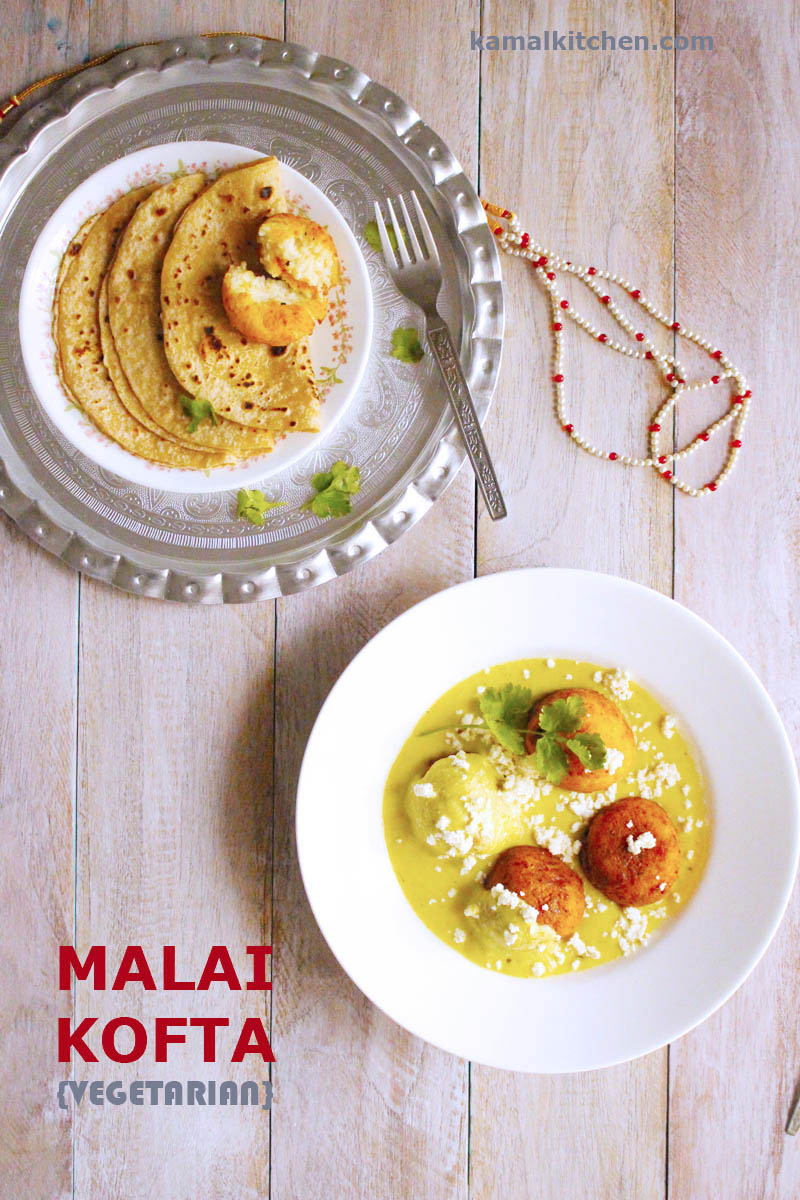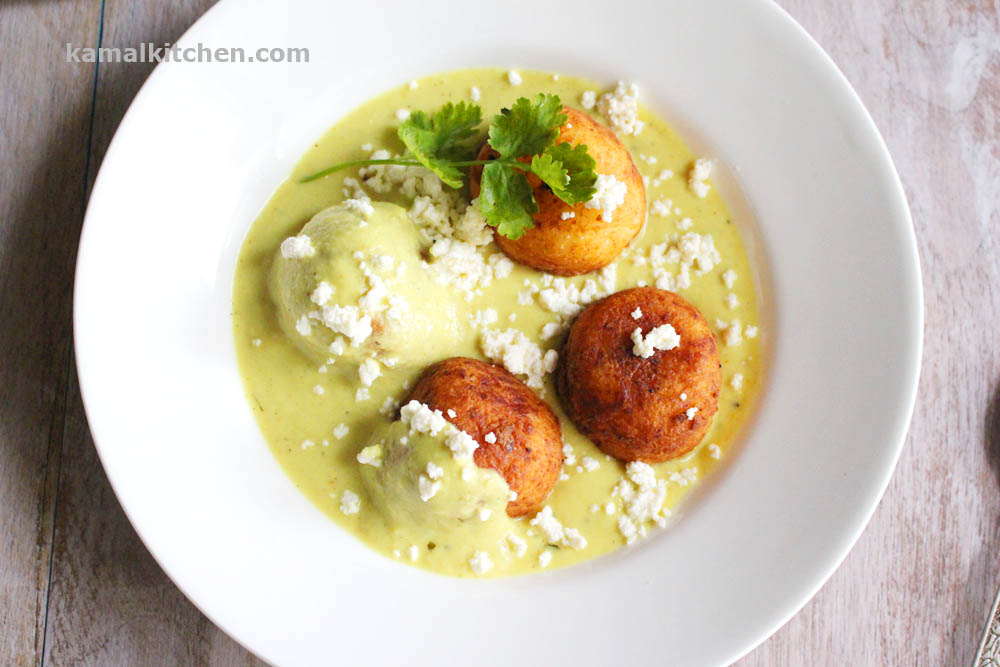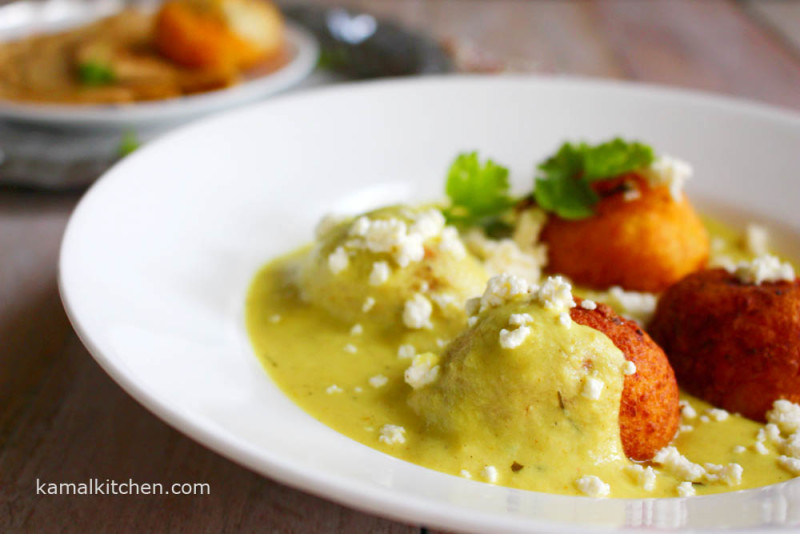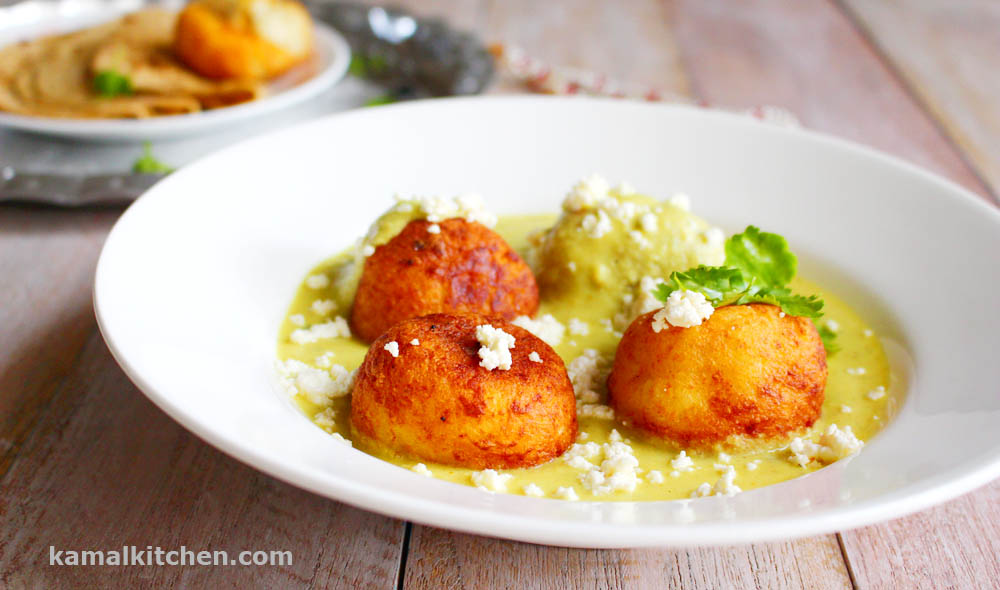Malai Kofta! Rich, cheesy dumplings spiced just right, dunked in a creamy masala sauce. I’m going back to classics today and trying to revive one of my favorite restaurant dishes that seems to have undergone a transformation for the worse. Here’s how I remember the Malai Kofta Recipe – Restaurant style.
A simple translation before we proceed – Malai is cream, and kofta refers to the fritters or dumplings.

When I was a child, Malai Kofta was what I ordered whenever we went out to eat. It is rich, creamy, decadent, with just a hint of sweetness. True to its shahi or royal roots, the Malai Kofta was a milder dish, something you ordered to round off that spicy curry. Considering how fatty it is, simply loaded with calories, I never really made it at home. And there’s frying involved! If anything can turn me off in a recipe, it is deep frying. And I was reminded why when I made this Malai Kofta recipe today.
Frying is a skill, one I have never tried to master. Ha!

So anyhoo, Malai Kofta recipe has suffered a rude transformation in the past few decades and met its Waterloo. The Malai Kofta you get in restaurants is mostly white in color, and is so sweet it hurts your teeth. Pick up the phone to order Malai Kofta from your friendly neighborhood restaurant and the first words you hear are ‘It will be sweet.’ Then you try and argue how it does not need to be. After a while, the person on the other side says, ‘It will be sweet.’ You either give in, bearing the wrath of the rest of the family, or forget about those Malai Kofta cravings.
A search for the Malai Kofta recipe on the web was futile. Most great chefs had the same recipe – add coriander, cumin, turmeric, chili, garam masala, etc. etc. etc. – and tons and tons of tomatoes. The old ‘add everything to everything’ mantra which I detest.
Food blogs were no different. So I thought the time had finally come for me to take on the Malai Kofta Challenge. Since I am my own worst critic, I will be honest and tell you what I think.

I think I almost nailed it. I added turmeric, but you can leave it out. I did not use tomatoes, and was glad. Tomatoes have invaded the Indian culinary scene. Almost every recipe has tomato puree or tomatoes added to it. But it does not need to!
I closed my eyes and thought back to the flavors of some of the best Malai Koftas I remembered. Two spices stood out. Cardamom and fenugreek. It kind of makes sense. Cardamom is a key ingredient in royal cuisine. It is so floral and so fragrant, it lends a unique flavor to any dish, especially a savory dish. Bitter fenugreek is perfect to cut through the richness from all the cream and nuts and cheese.
All said, this recipe is quite low cal compared to what you might get in a restaurant. Frying the koftas or the dumplings is the most crucial and the most tedious (for me) step. I almost faltered in the frying process, but then adding more flour, and more flour, saved the day.

I went off track and tried using something different instead of Khoya or Mawa – gulab jamun mix. In retrospect, I think milk powder will make a better substitute. You can try baking these dumplings or koftas in the oven – save time and some calories.
Don’t be fooled by the title. This Malai Kofta recipe is appropriately spiced. The garam masala creates a warmth in your throat as it goes down.
Note: Garam Masala is a very potent spice. The half teaspoon used here is the perfect balance for this dish.
Serve this Malai Kofta with any kind of Indian bread like roti, paratha, chapati etc. You can also serve it with plain steamed rice. Plain tortillas or pita bread is also a good store bought option.
Malai Kofta Recipe
Ingredients
- 6-8 medium potatoes, boiled
- 1 cup paneer, crumbled
- ½ - 1 cup milk powder or mawa powder
- ½ - 1 cup All Purpose Flour or Maida
- ¼ tsp minced green chili or cayenne pepper
- ¼ tsp cardamom powder
- ¼ tsp fenugreek, ground
- Salt to taste
- 1 medium onion
- ½ cup cashews/ almonds or mix
- ¼ cup melon seeds (optional)
- 2 inch ginger, chopped
- 5-6 cloves garlic, chopped
- ½ tsp Garam Masala
- ¼ tsp turmeric, ground (optional)
- Pinch of cayenne pepper
- ¼ tsp cardamom, ground
- ¼ tsp fenugreek, ground or
- ¼ tsp Kasoori Methi
- ½ tsp sugar
- Salt to taste
- 2-3 Tbsp heavy cream
- 2 Tbsp oil + more for deep frying
- Cilantro or crumbled paneer for garnish
Method
- Chop onion, ginger and garlic coarsely. Put in a stock pot along with the nuts and seeds, cover with water and bring to a boil. Simmer for 5-10 minutes until the onion softens. Cool completely.
- Blend the above mixture to form a smooth, thick paste. Use as little water as needed.
- Heat 2 Tbsp oil in a wok or pan. Add the Masala paste to the oil and stir on medium heat until it becomes toasty and light brown. Add water half cup at a time if the paste sticks. This process will take 15-20 minutes. Once liquid dries, add more and continue until the spice paste is cooked through.
- Add turmeric and the spices, sugar and salt, and a cup of water. Whisk well and bring to a simmer. Switch off heat, and reheat just before serving.
- Boil potatoes, drain, peel and grate. I generally boil/ pressure cook the potatoes a day before and refrigerate them. This gives them a firmer texture.
- Grate or crumble paneer cheese. Ricotta might be subbed for the paneer here.
- Mix grated potatoes, paneer cheese, milk powder, flour, cardamom, cayenne or chili together to form a smooth dough. Add salt only at the last moment while rolling the dumplings.
- Heat oil in a wok. Form large jumbo sized balls with the dough. Roll them in flour, dust it off, and deep fry until golden.
- To serve – Reheat the sauce. Add in the heavy cream and switch off heat. Mix the cream in well.
- Place the koftas or dumplings in the serving plate and pour sauce over them. Serve immediately with roti or rice.
Malai Kofta is certainly a special dish and takes more effort. I’m gonna save it for special occasions like birthdays or festivals. But any day you make this is going to be special.
Go ahead, give it a try, and let me know how you liked it.

Leave a Reply